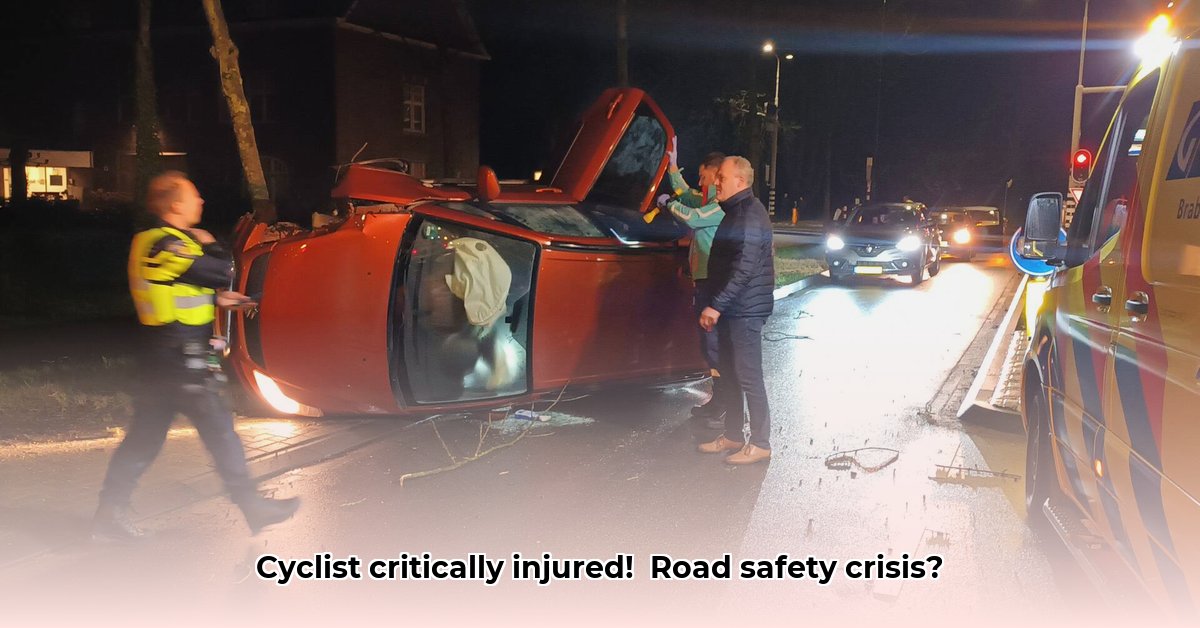
A Serious Cycling Accident on the Eindhovenseweg
A serious cycling accident on the Eindhovenseweg in Geldrop has left a cyclist with severe injuries, prompting urgent calls for improved road safety. The gravity of the situation necessitated the deployment of a medical helicopter, highlighting the vulnerability of cyclists on our roads. This incident serves as a stark reminder of the need for safer cycling infrastructure and responsible road usage.
Unpacking the Eindhovenseweg Incident
The accident occurred on the Eindhovenseweg, a busy road in Geldrop. While a full police investigation is underway, initial reports suggest a collision between a cyclist and a motor vehicle. The cyclist sustained serious injuries requiring immediate medical intervention via air ambulance. The precise circumstances remain unclear, pending the conclusion of the police investigation. But the incident shines a light on the inherent risks faced by cyclists sharing the road with motor vehicles. Have you ever felt unsafe cycling in Geldrop?
Did you know that cycling accidents often involve factors beyond the immediate collision? For instance, poor lighting, a lack of dedicated bike lanes, or high traffic volumes can substantially increase the risk? These are all elements the investigation will scrutinise.
Investigating the contributing factors:
Several factors could have contributed to this accident. The investigation will explore the following possibilities: driver error (perhaps distracted driving or excessive speed); inadequate cycling infrastructure (lack of cycle lanes, poor visibility, insufficient signage); and environmental conditions (lighting, weather, road surface). The police and municipality will work together to gather all evidence and understand the sequence of events. This incident underscores the need for a holistic approach to road safety, going beyond just immediate responses.
The Eindhovenseweg: A Focus on Infrastructure
The Eindhovenseweg, a major road in Geldrop, carries a substantial volume of traffic daily. This accident brings the road's safety, particularly for cyclists, under intense scrutiny. The absence of dedicated cycle lanes along sections of the Eindhovenseweg has been a recurring concern raised by residents and cycling advocacy groups. Such a lack of dedicated pathways could significantly increase the risk of accidents, as cyclists are forced to share the road with faster-moving vehicles.
Is it enough simply to investigate the facts of this one incident, or do we need a broader review?
A Plan of Action: Short-Term and Long-Term Strategies
The aftermath of this accident demands immediate and long-term action on multiple fronts. A coordinated response, involving local government, law enforcement, and cycling advocacy groups, is crucial.
Short-Term Actions (0-12 Months):
Thorough Accident Investigation: A comprehensive investigation by the Municipality of Geldrop-Mierlo is vital to pinpoint immediate safety concerns requiring urgent attention. This will involve a careful examination of the accident scene, witness statements, and potentially forensic evidence. This process will inform future safety measures, creating a safer environment for all road users.
Accelerated Police Investigation: The police investigation needs to proceed swiftly to determine the exact circumstances and any factors that might have contributed. This information will inform both immediate safety improvements and long-term policy changes.
Immediate Safety Enhancements: Collaborative work between the municipality and cycling advocacy groups is needed to implement interim solutions, such as improved temporary signage, increased police patrols in high-risk areas, and temporary speed restrictions. This agile approach addresses immediate risks and prevents similar incidents while larger changes are implemented.
Long-Term Actions (1-5 Years):
Infrastructure Upgrade: The Municipality of Geldrop-Mierlo must develop a comprehensive plan for creating safe, dedicated cycle paths along the Eindhovenseweg and other vulnerable routes. This would include considerations for proper lighting, clear signage, and a design that prioritises cyclist safety. Regular safety audits should ensure ongoing compliance.
Targeted Community Awareness Campaigns: Joint efforts by the Police and Municipality are crucial to educate drivers and cyclists on safe road sharing practices. This could involve community workshops, social media campaigns, and school programs tailored to increase awareness and promote responsible behaviour on the roads.
Sustained Advocacy and Collaboration: Cycling advocacy groups must remain active participants in the process, providing informed input during infrastructure planning, helping develop effective educational programmes, and advocating for legislative changes giving cyclists increased safety and protection.
Sharing the Road: A Collective Responsibility
This accident underscores the need for shared responsibility. The Municipality, Police, drivers, and cyclists all have a vital role in creating safer roads. Effective infrastructure is essential, but equally important is a cultural shift towards more responsible road usage among all road users. This incident should be a catalyst for positive change. Let's ensure the injured cyclist's recovery serves as more than just a solemn reminder – turning it into a springboard for long-lasting improvements in road safety.
Key stakeholders and their roles:
| Stakeholder | Key Role |
|---|---|
| Municipality | Infrastructure development, traffic management, public awareness campaigns |
| Police | Law enforcement, accident investigations |
| Cycling Advocacy Groups | Representing cyclists' interests, advocating for infrastructure improvements |
| Drivers | Responsible driving behaviours, sharing the road safely with cyclists |
| Cyclists | Safe cycling practices, using appropriate signalling, wearing protective gear |
Let's work together to make Geldrop's roads safer for everyone.